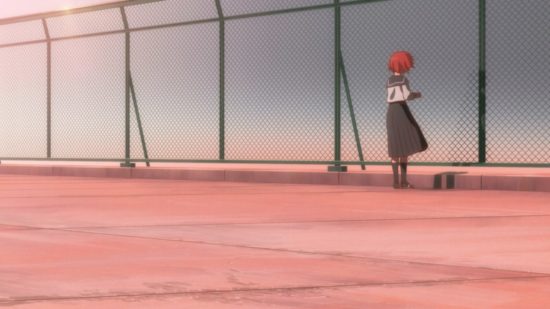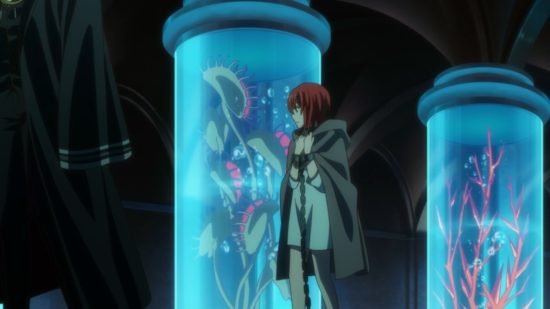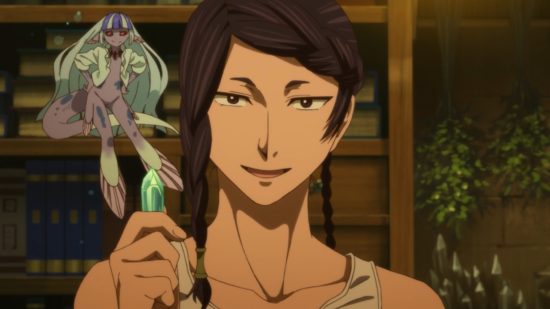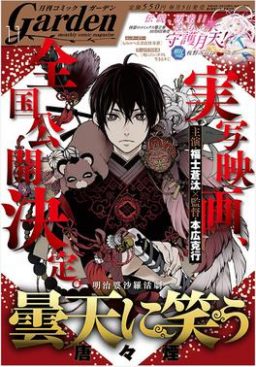
The Ancient Magus’ Bride (Crunchyroll) was one of the most anticipated anime series of the fall season thanks to buzz from fans of the original manga and a well-received 3-part OVA prequel (The Ancient Magus’ Bride: Those Awaiting a Star, also on Crunchyroll.)
(Strunk and White say that it should be “Magus’s Bride” but I’ll stick with the official title. The Japanese title is “Mahoutsukai no Yome” or “Bride of the Magic User.”)
The series has a lot to offer including a rich, original fantasy world. The animation looks terrific (at a time when even Japanese animation all too often looks like crap.) The story has some problematic elements but I have reason to hope that they will improve as it progresses.

Chise Hatori is a teenage girl (I think she’s about 15) who feels at the end of her rope. She has been shunned and bullied since early childhood because she can see spirits, causing most people to consider her weird or crazy.

When she was a little girl her mother killed herself. Since then she has been shuttled between various relatives who don’t want her.

Not caring whether she lives or dies she decides to sell herself to some sleazy occultists. (There’s probably more to this backstory that we haven’t been shown yet.)


They take her to a large auction house where all sorts of magical beings may be purchased and proceed to auction her off.


At this point Elias Ainsworth, also known as the “Thorn Mage,” bursts into the room and proceeds to buy her for an outrageous sum.

Elias is an intimidating figure: abnormally tall, ramrod straight, with a head that looks like an antelope skull and eyes that resemble glowing coals.

Understandably he usually covers his face in public, or hides in the shadows (which he is very good at.) He mostly lives as a recluse, allowing few visitors.

Elias magically transports her to his home, a picturesque cottage in the English countryside somewhere west of London.

Elias tells Chise that he intends to make her his apprentice–and also his bride. She is shocked but doesn’t object. (So far she has been wandering though the story like a dazed disaster survivor.)

He also explains that she is a “Sleigh Beggy” (or “Slay Vega” in the manga translation.) This means that she is very attractive to fairies and other spirits who will surround her and try to do her favors. More often than not these “favors” are actually harmful.
(He doesn’t mention that such people rarely survive to adulthood.)

Silky is a fairy who acts as Elias’s housekeeper. She is loyal, competent and silent.

Elias takes Chise to London to see a maker of magical objects. He uses magic to make his face look normal but Chise, showing more spirit than she has previously, tells him it looks fake. (I kind of see her point. It reminds me of the prince in Disney’s original Beauty and the Beast.)

The magical craftsman is Angelica Varley, a strong, confident woman with a young daughter who is also undergoing magical training.

Angelica explains that there are two kinds of magic users. “Sorcerers” (majutsushi) treat magic as a force that can be scientifically studied and systematically manipulated. “Mages” (mahoutsukai) perform magic by working with fairies and other spirits.
Angelica and Elias are both mages and she obviously doesn’t think much of sorcerers.

(Translation quibble: majutsushi is literally “master of the dark arts” so “sorcerer” seems a good enough translation. Mahoutsukai just means “magic user” but “mage” or “magus” originally meant a Zoroastrian priest, which seems a bit off. Given Angelica’s description “conjurer” might be better but unfortunately that has come to mean “stage magician” in England. The best fit, given the story setting, might actually be “druid.”)

In any case this is obviously a risky business. Angelica shows Chise the gem-like scars on her arm caused by a moment of carelessness during her training. (Did something like that happen to Elias?)

When they return home Elias receives a visit from Simon Kalm, the priest of the local village church. The meeting starts out awkwardly and becomes more awkward after Simon suggests to Chise that he can offer her protection if she is being abused.

Some of the awkwardness may be due to Elias’s reclusiveness and general social ineptitude. However there are also suggestions of a troubled history between mages and Church authorities.
Simon however values Elias as a representative of thousands of years of ancient British traditions. He has three problems that he asks Elias to investigate. (He also receives a fourth favor in the form of some healing potions.) The next few episodes will involve Elias’s attempts to follow up on Simon’s requests.

Lindel (a.k.a. “Lindenbaum” a.k.a. “Echoes”) is a mage who runs a sanctuary for dragons in the remote reaches of Iceland. In spite of his youthful appearance and carefree manner he is older than Elias by many centuries. He privately warns Elias that unless Chise learns to control her powers she is sure to die within three years.

Nevin is an ancient dragon on the verge of death, but before he dies he has some wisdom to impart to Chise.

My major problem with this so far is that the heroine is annoyingly passive. She quietly accepts whatever happens to her and never stands up for herself.
It’s pretty routine for shoujo heroines to start out weak. In the better stories they gradually get stronger and I hope this will happen here. In fact it pretty much has has to happen since it’s been spelled out repeatedly that Chise will die soon if she doesn’t get a grip and master her powers.

Another shoujo trope is that potential boyfriends start out as some combination of intimidating, obnoxious or excessively powerful. In the better stories they gradually get better. Elias seems well-intentioned but he can also be an insensitive jerk, so there’s clearly room for improvement here.

Why do I say this is a shoujo story when the Wikipedia article calls it shounen? That’s because I see more shoujo than shonen tropes in it.

However to me they appear to be mixed-demographic magazines that publish a mixture of shounen and shoujo stories. Just look at these covers. Do they really look shounen to you?


